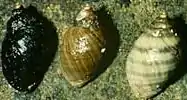Nucella emarginata
Nucella emarginata, common name the emarginate dogwinkle, is a species of medium-sized predatory sea snail, a marine gastropod mollusk in the family Muricidae, the murex snails or rock snails.[1]
| Nucella emarginata | |
|---|---|
 | |
| Scientific classification | |
| Kingdom: | |
| Phylum: | |
| Class: | |
| (unranked): | |
| Superfamily: | |
| Family: | |
| Subfamily: | |
| Genus: | |
| Species: | N. emarginata |
| Binomial name | |
| Nucella emarginata (Deshayes, 1839) | |
| Synonyms[1] | |
| |
Description
N. emarginata is a rocky intertidal gastropod carnivore that feeds on a variety of sessile and sedentary species such as barnacles, mussels, and limpets.[2] The adult shell size of this species can reach 25 mm or 30 mm.
Feeding
N. emarginata attacks prey by drilling. It has a special organ called the accessory boring organ, or ABO, that contains acid which it uses to dissolve a small hole in the shell of its prey.[3][4][5] When drilling, it alternates acid secretions with scraping by its radula until it has fully penetrated the prey's shell, leaving a characteristic hole about 1 mm in diameter.[5] The speed of this process likely depends on temperature,[6] and the size of the hole depends on the size of the dogwhelk's accessory boring organ, which is generally larger in larger dogwhelks.[7] Finally, when the hole is complete, the dogwhelk inserts its proboscis into the hole to feed.
Distribution
This species lives in mid-intertidal zones and often lives among mussels such as Mytilus californianus.[8] Formerly known as N. ostrina, the two species were differentiated based on shell morphology, reproductive compatibility, and genetic sequencing in 1990.[8] N. emarginata is now known to be distributed between Fort Point, California and Pacific Mexico.[9]
References
- Nucella emarginata (Deshayes, 1839). Retrieved through: World Register of Marine Species on 10 January 2011.
- West, L., 1986. Interindividual variation in prey selection by the snail Nucella (= Thais) emarginata. Ecology 67, 798–809. https://doi.org/10.2307/1937702
- Gruber, G.L., Carriker, M.R., 1990. A note on the accessory boring organ and shell boring by the "Loco", Concholepas concholepas (Muricidae, Gastropoda). Bulletin of Marine Science 47, 739–744.
- Carriker, M.R., Gruber, G.L., 1999. Uniqueness of the Gastropod Accessory Boring Organ (ABO) Comparative Biology, an Update. Journal of Shellfish Research 18, 579–595.
- Carriker, M.R., 1981. Shell penetration and feeding by Naticacean and Muricacean predatory gastropods: a synthesis. Malacologia 20, 403–422
- Miller, L.P., 2013. The effect of water temperature on drilling and ingestion rates of the dogwhelk Nucella lapillus feeding on Mytilus edulis mussels in the laboratory. Marine Biology 160, 1489–1496. https://doi.org/10.1007/s00227-013-2202-z
- Kowalewski, M., 2004. Drill holes produced by the predatory gastropod Nucella lamellosa (Muricidae): Palaeobiological and ecological implications. Journal of Molluscan Studies 70, 359–370. https://doi.org/10.1093/mollus/70.4.359
- Palmer, A., Gayron, S., Woodruff, D., 1990. Reproductive, morphological, and genetic evidence for two cryptic species of Northeastern Pacific Nucella. The Veliger 33, 15.
- Marko PB (1998) Historical allopatry and the biogeography of speciation in the prosobranch snail genus Nucella. Evolution (NY) 52:757–774
External links
- "Nucella emarginata". Gastropods.com. Retrieved 10 January 2011.
- A Snail's Oddyssey: Whelks and Relatives